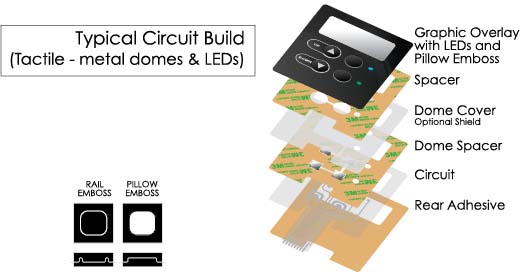How Membrane Switches Are Shaping the Future of Electronic Interfaces
How Membrane Switches Are Shaping the Future of Electronic Interfaces
Blog Article
Comprehending Membrane Layer Switches Over: The Key to Durable and Reputable Controls

What Are Membrane Switches?
Membrane switches are an innovative service in the realm of customer interface innovation, integrating functionality and layout seamlessly. These gadgets serve as an interface between users and electronic systems, incorporating several components into a small style. Commonly constructed from flexible, thin layers of materials, membrane switches are created to react to touch, allowing users to connect with equipment and digital gadgets successfully.
The key components of a membrane layer button consist of a printed circuit layer, graphic overlay, and a spacer layer that avoids unintentional activation. The graphic overlay can be customized to reflect brand identification or customer choices, boosting aesthetic appeals while making certain use. Membrane layer buttons are generally made use of in numerous applications, consisting of clinical tools, consumer electronics, and industrial tools, owing to their durability and resistance to environmental aspects such as wetness and dirt.
Among the vital benefits of membrane layer switches is their capability to stand up to damage, making them ideal for high-traffic environments. In addition, they are light-weight and require marginal space, enabling cutting-edge layouts in item growth. On the whole, membrane switches over stand for a sensible and effective selection for contemporary electronic user interfaces, weding technology with user-centric design concepts.
Exactly How Membrane Layer Switches Over Work
The operation of membrane layer switches hinges on a straightforward yet effective system that converts user input into digital signals. When a customer presses the switch, the top layer warps, permitting a conductive element in the circuit layer to make contact with a matching conductive pad on the bottom of the graphic overlay.
The design of membrane buttons can differ, yet they typically include domes or tactile elements to supply responses to the customer, enhancing the overall experience - membrane switch. The materials utilized in membrane layer buttons, such as polyester or polycarbonate, add to their resilience and resistance to ecological aspects, consisting of dampness and dirt. The published circuits are commonly enveloped, which protects them from wear and tear over time.
Benefits of Membrane Layer Buttons

Additionally, membrane layer buttons are known for their sturdiness. Created from robust materials, they are resistant to dirt, moisture, and physical wear, which substantially expands their life expectancy Full Report contrasted to typical mechanical buttons. This durability makes them particularly appropriate for high-traffic atmospheres and applications needing durability.
One more considerable advantage is the simplicity of cleaning and upkeep. The smooth surface area of membrane layer switches over lessens dirt build-up and is usually unsusceptible spills, making them ideal for setups that call for constant sanitization.
Additionally, membrane layer switches provide a streamlined profile, leading to a thinner layout that can be incorporated right into different devices without adding mass. This function not only enhances the visual allure however likewise contributes to a more ergonomic item layout.
Applications of Membrane Layer Switches
Versatile and user-friendly, membrane switches locate applications across a broad range of industries, consisting of clinical devices, consumer electronic devices, and industrial devices. In the medical field, these switches are indispensable to gadgets such as analysis tools, individual surveillance systems, and mixture pumps, where dependability and simplicity of cleaning are critical. Their capacity to maintain and withstand rough atmospheres performance makes them ideal for such applications.

In customer electronics, membrane layer switches are made use of in items like microwaves, cleaning devices, and remote controls - membrane switch. Their smooth design enables user-friendly user interfaces, boosting the overall user experience while supplying toughness and resistance to damage
Industrial devices also takes advantage of membrane buttons, particularly look at this site in control panels for machinery and automation systems. These buttons provide defense versus dust and wetness, making certain regular efficiency in challenging atmospheres. Their adjustable attributes permit manufacturers to tailor them to particular operational requirements, improving performance and capability.
Picking the Right Membrane Layer Switch
When selecting a membrane switch, it is important to think about different variables that influence efficiency and viability for certain applications. The key factors to consider consist of ecological conditions, tactile feedback, resilience, and style specs.
First, examine the operating setting; buttons revealed to dampness, chemicals, or severe temperatures need certain products to make sure durability and capability. Next off, examine the demand for responsive responses. Relying on individual interaction, some applications may benefit from a tactile reaction to confirm activation, while others might favor a non-tactile layout for visual reasons.
Sturdiness is one more essential element; membrane layer switches must be made to hold up against frequent usage, influences, and abrasion. Make sure the selected button can sustain the anticipated lifecycle, particularly in high-usage circumstances.

Conclusion
Finally, membrane changes serve as necessary elements in the layout of trusted and sturdy control systems throughout different industries. Their compact design, combined with durable construction and customizable attributes, enhances customer communication while making certain durability sought after settings. The adaptability of membrane changes allows for customized services that fulfill particular functional needs, enhancing their importance in modern-day technology. As sectors remain to advance, the significance of incorporating effective membrane layer switch options can not be overemphasized.
Membrane layer changes represent a vital facet of modern-day interface style, blending performance with strength in various applications.Membrane switches are an advanced remedy in the realm of individual interface modern technology, combining performance and layout seamlessly. Normally created from adaptable, thin layers of materials, membrane switches are created to react to touch, enabling individuals to connect with equipment and electronic gadgets successfully.
The layout of membrane switches can vary, yet they typically incorporate domes or tactile aspects to give feedback to the user, enhancing the general experience.In verdict, membrane layer switches over serve as important elements in the style of sturdy and dependable control systems throughout numerous sectors.
Report this page